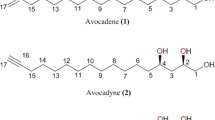Abstract
The bioactivity of four flavonoid compounds, namely poncirin, rhoifolin, naringin and marmesin, from Poncirus trifoliata was studied against the Aedes aegypti. Larvicidal assays were conducted to evaluate the 24 h LC50 and LC90 values of the flavonoid compounds. The lethal concentration (LC50 and LC90) values ranged from 0.082 to 0.122 mg/l and 0.152 to 0.223 mg/l, respectively. The result of ovicidal test suggests that the ovicidal activity of the flavonoid compounds was influenced by the concentration of flavonoid compounds and age of the eggs. The result of oviposition test showed that the four flavonoid compounds exhibited oviposition-deterrent activity against gravid female mosquitoes. Oviposition decreased with an increase in concentration of flavonoid compounds. A laboratory test was carried out to evaluate protection period and percentage of repellency of four compounds diluted in ethanol (10 mg/l). The compound rhoifolin provided maximum 365.0 ± 12.0 min protection and also 100.0% ± 0.0 repellency against mosquito bite followed by poncirin, marmesin and naringin. None of the 25 volunteers of either sex exposed to 10% (w/v) flavonoid compounds (4-h patch test) showed a positive skin irritant reaction. All of the tested compounds proved to have various activities against different life stages of A. aegypti. Therefore, flavonoid compounds from P. trifoliata can be a potential candidate for use in the development of commercial mosquitocidal products that may be an alternative to conventional synthetic chemicals, particularly in integrated vector control applications.
Similar content being viewed by others

References
Amer A, Mehlhorn H (2006) Repellency effect of forty-one essential oils against Aedes, Anopheles and Culex mosquitoes. Parasitol Res 99:478–490
Basketter DA, Chamberlain M, Griffiths HA, Rowson M, Whittle E, York M (1997) The classification of skin irritants by human patch test. Food Chem Toxicol 35:845–852
Cheng SS, Liu JY, Tsai KH, Chen WJ, Chang ST (2004) Chemical composition and mosquito larvicidal activity of essential oils from leaves of different Cinnamomum osmophloeum provenances. J Agric Food Chem 52:4395–4400
Curtis CF, Lines JD, Baolin L, Renz A (1989) Natural and synthetic repellents. In: Curtis CF (ed) Appropriate technology in vector control. CRC, New York, pp 75–92
Davis EE, Bowen FM (1994) Sensory physiological basis for attraction in mosquitoes. J Am Mosq Control Assoc 10:316–325
Finney DJ (1971) Probit analysis: a statistical treatment of the sigmoid response curves, 3rd edn. Cambridge University Press, London, p 333
Fradin MS, Day JF (2002) Comparative efficacy of insect repellents against mosquito bites. N Engl J Med 347:13–18
Govindarajan M, Jebanesan A, Pushpanathan T (2008) Larvicidal and ovicidal activity of Cassia fistula Linn. leaf extract against filarial and malarial vector mosquitoes. Parasitol Res 102:289–292
Murugan K, Murugan P, Noortheen A (2007) Larvicidal and repellent potential of Albizzia amara Boivin and Ocimum basilicum Linn against dengue vector, Aedes aegypti (Insecta : Diptera : Culicidae). Biores Technol 98:198–201
Rajkumar S, Jebanesan A (2004a) Mosquitocidal activities of octacosane from Moschosma polystachyum Linn (lamiaceae). J Ethnopharmacol 90:87–89
Rajkumar S, Jebanesan A (2004b) Ovicidal activity of Solanum trilobatum Linn (Solanaceae) leaf extract against Culex quinquefasciatus Say and Culex tritaeniorhynchus Gile (Diptera:Culicidae). Inter J Tropi Insec Sci 24(4):340–342
Rajkumar S, Jebanesan A (2008) Bioactivity of Chenopodium ambrosioides (Family: Chenopodiaceae) against the filariasis vector Culex quinquefasciatus Say (Diptera: Culicidae). Can J Pure Appl Sci 2(1):129–132
Rastogi RP, Mehrotra BN (1995) Compendium of Indian medicinal plants. Drug Research Perspectives, A CDRI Series
Scott TW, Chow E, Strickman D, Kittayapong P, Writz RA, Lorenz LH, Edman JD (1993) Blood feeding pattern of Aedes aegypti (Diptera : Culicidae) collect in a rural Thai village. J Med Entomol 30:922–927
Shaalan EAS, Canyon D, Younes MWF, What HA, Mansour AH (2005) A review of botanical phytochemicals with mosquitocidal potential. J Env Int 31:1149–1166
Su T, Mulla MR (1999) Oviposition bioassay responses of Culex tarsalis and Culex quinquefasciatus to neem products containing azadirachtin. Entomol Exp Appl 91:337–345
Su T, Mulla MS (1998) Ovicidal activity of neem products (Azadirachtin) against Culex tarsalis and Culex quinquefasciatus (Diptera: Culicidae). J Am Mosq Control Assoc 14(2):204–209
Tawatsin A, Wratten SD, Scott RR, Thavara V, Techadamrongsin Y (2001) Repellency of volatile oils from plants against three mosquito vectors. J Vector Ecol 26:77–82
Usta J, Kreydiyyeh S, Bakajian K, Nakkash-Chmaisse H (2002) In vitro effect of eugenol and cinnamaldehyde on membrane potential and respiratory complexes in isolated rat liver mitochondria. Food Chem Toxicol 40:935–940
Wandscheer CB, Duque JE, Silva MAN, Fukuyama Y, Wohlke JL, Adelmann J, Fontana JD (2004) Larvicidal action of ethanolic extracts from fruit endocarps of Melia azedarach and Azadirachta indica against the dengue mosquito Aedes aegypti. Toxicon 44:829–835
WHO (2005) Guidelines for laboratory and field testing of mosquito larvicides. WHO/CDS/WHOPES/GCDPP/2005.13
Xue RD, Barnard DR, Ali A (2001) Laboratory and field evaluation of insect repellents as oviposition deterrents against the mosquito Aedes albopictus. Med Vet Entomol 15:126–131
Acknowledgement
The authors are thankful to the professor and head of the Department of Zoology, Annamalai University for facilities provided and Head of the Department of Zoology, AVC College for his generous support. Special thanks also goes to the Central Drug Research Institute, Lucknow for providing the isolated flavonoid compounds. We also wish to thank volunteers for their help during the course of experiment.
Author information
Authors and Affiliations
Corresponding author
Rights and permissions
About this article
Cite this article
Rajkumar, S., Jebanesan, A. Bioactivity of flavonoid compounds from Poncirus trifoliata L. (Family: Rutaceae) against the dengue vector, Aedes aegypti L. (Diptera: Culicidae). Parasitol Res 104, 19–25 (2008). https://doi.org/10.1007/s00436-008-1145-7
Received:
Accepted:
Published:
Issue Date:
DOI: https://doi.org/10.1007/s00436-008-1145-7



